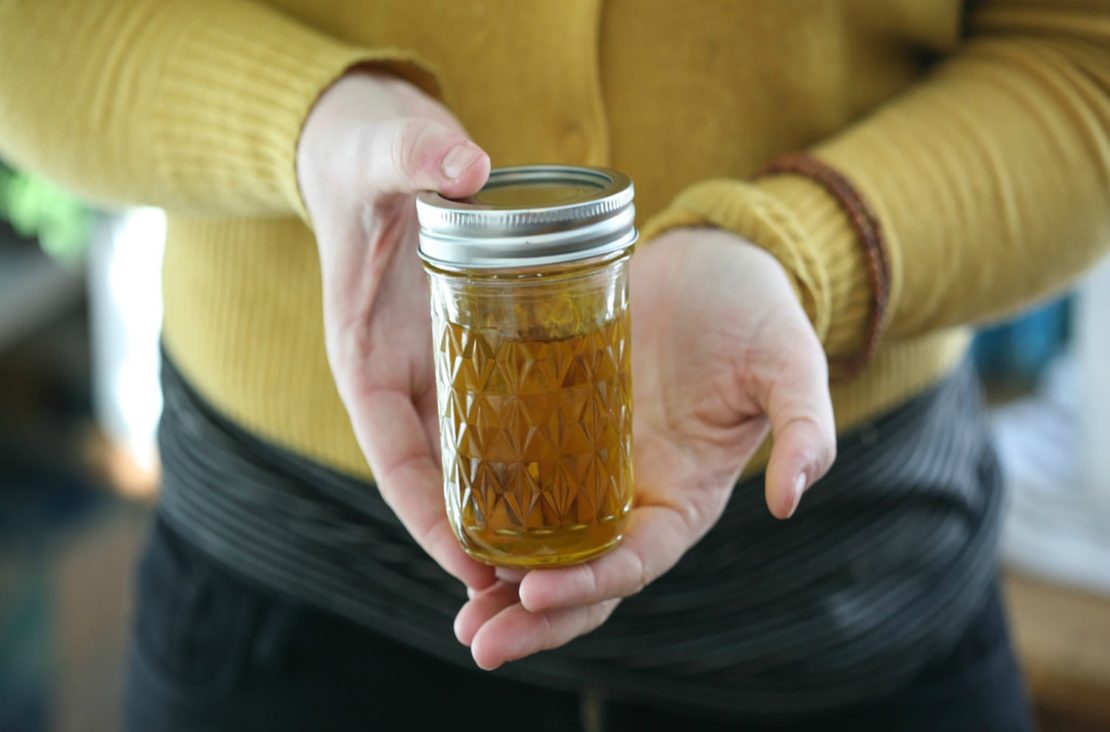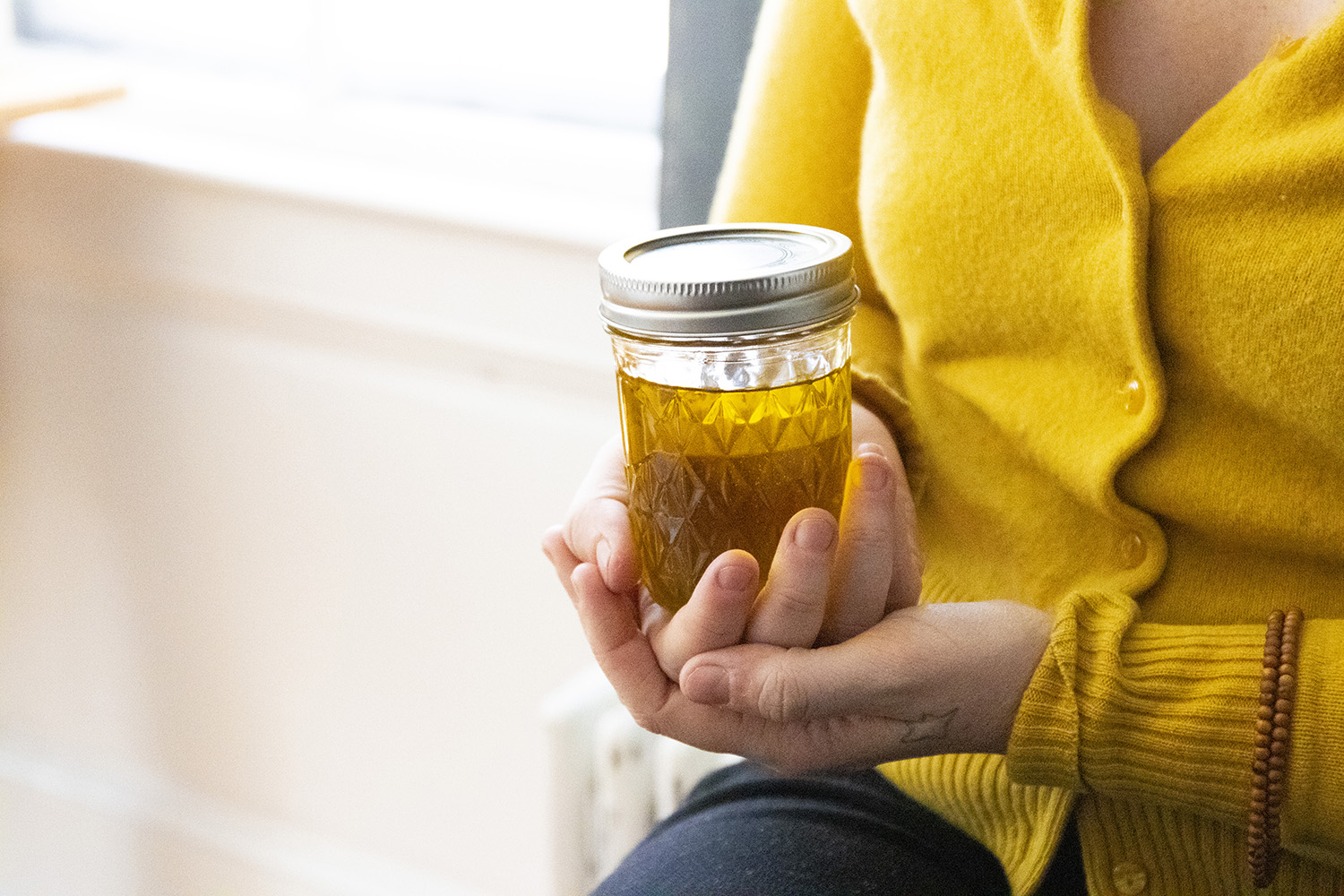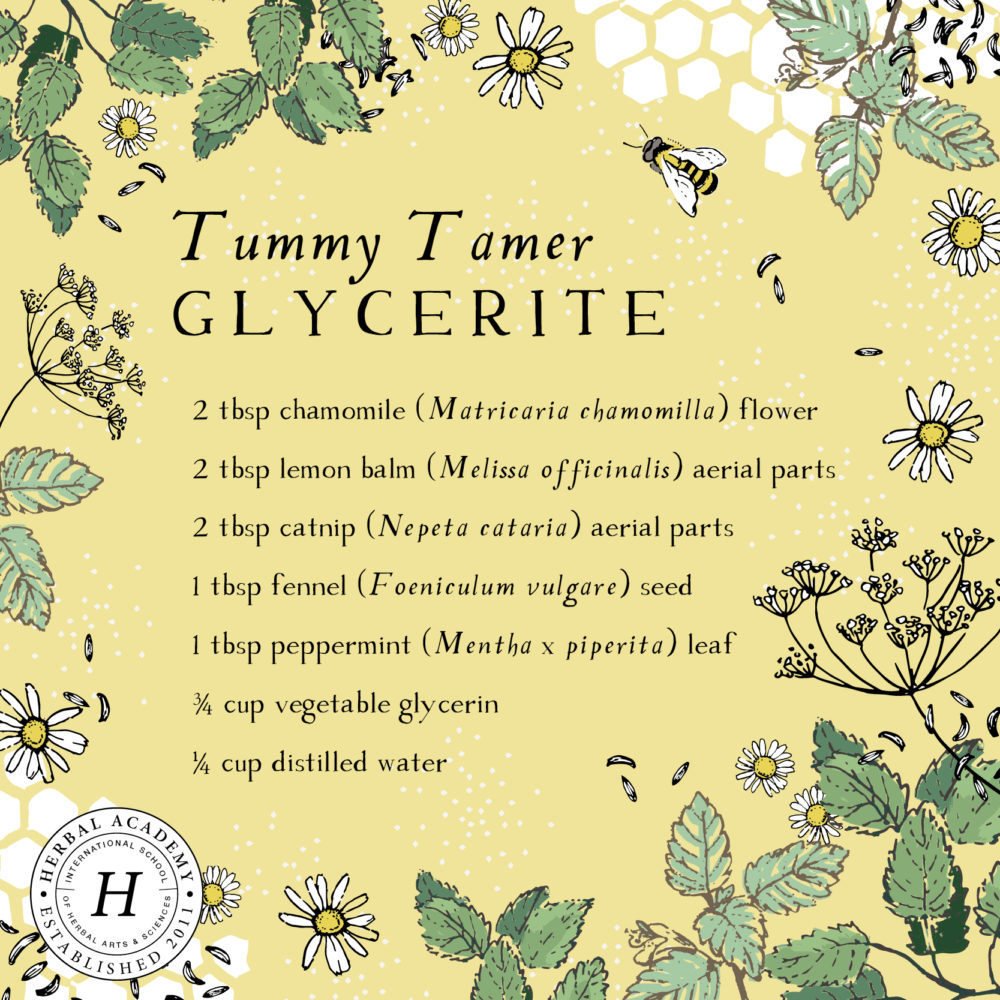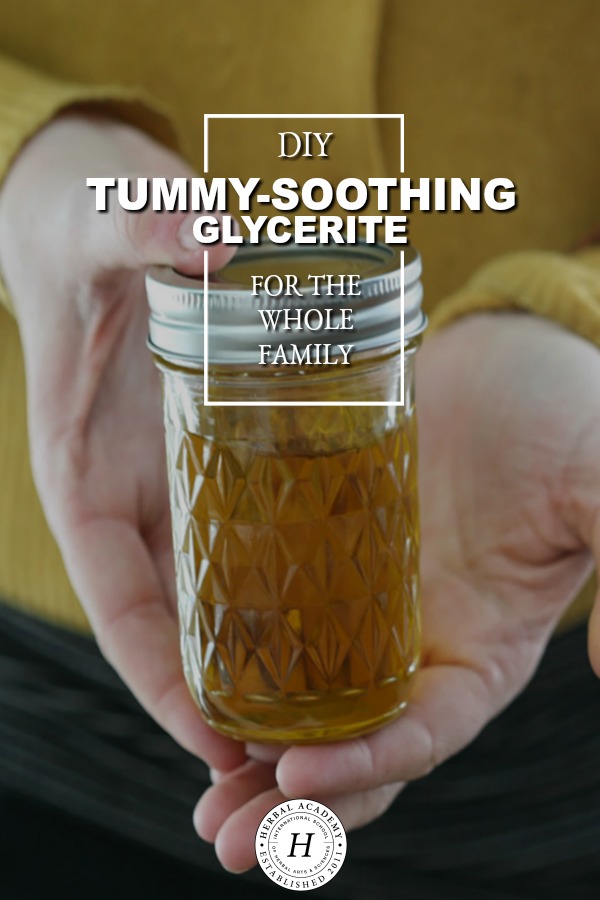
A Delicious Tummy Tamer Glycerite for the Whole Family
Like me, you may periodically experience trouble with digestion after a big meal with symptoms including stomach cramps, gas, pain, bloating, and general unease. For many years, I searched unsuccessfully for a formula to ease my stomach and gastrointestinal issues. I found that over-the-counter formulas were too harsh and contained unwanted side effects. Unfortunately, some natural formulas were ineffective while others felt too strong for my sensitive constitution. My journey into herbalism led me to experiment with herbal formulas that would also benefit my family, thus I created this tummy-soothing glycerite that not only helps tame stomach woes and colic in children but tastes great, too!
Benefits of a Tummy-Soothing Glycerite
Poor food combining, eating too rapidly, food intolerances, and food choices that are spicy or high in fat are all some of the reasons that you may experience stomach pain and cramping after a meal. While there are many formulas that can help with digestion, this combination of carminative, antispasmodic, and nervine herbs is one that works well for me by helping me to relax and is soothing to my digestive tract. In addition to gentle herbal nervines that are kid-friendly, I use vegetable glycerin as the menstruum to extract the beneficial properties of the herbs, making this formula for a tummy-soothing glycerite a safe choice for the entire family.

What is a Glycerite?
A glycerite is an herbal tincture that uses vegetable glycerin as a means to extract herbal constituents instead of alcohol. Glycerin is used instead of an alcohol-based tincture as a safe alternative for children to take and for individuals who are sensitive to alcohol (Green, 2000). Vegetable glycerin is a clear and odorless liquid produced from vegetable fats and oils such as palm, soybean, and coconut (Petre, 2018). It has a sweet and tasty flavor that makes you (and your little ones) believe that you must be getting some sort of treat! If you are a parent, you know that offering a treat is sometimes the easiest way to deliver herbal formulas!
Note: Despite their pleasant flavor, glycerites are not in fact treats. They should be stored out of reach of children and only administered by an adult.
A best practice when purchasing glycerin is to ensure that it is sourced from a company that uses sustainable practices and is GMO-free and organic. When making glycerites, it is also preferable to use fresh plant matter, as glycerin is not as effective in drawing out the beneficial properties of herbs which have been dried. However, a water and glycerin mixture can be added to dried herbs to better extract plant constituents from the plant matter. A glycerite tincture should contain at least 55-60% glycerin (Green, 2000). For this tummy-soothing glycerite recipe, I use a 3:1 ratio of vegetable glycerin to filtered water.

About the Tummy Tamer Herbs
Chamomile (Matricaria chamomilla)
Chamomile has been traditionally used for centuries for digestive problems (Chevallier, 2000). It is believed that chamomile relaxes the smooth muscles of the digestive tract, helping to relieve spasms, and digestive discomforts such as bloating, abdominal pain, and gas (Zak, 1999). It is also often used as an after-dinner tea to ease digestion. Chamomile is a carminative, antispasmodic, anti-inflammatory, and nervine which makes it beneficial for individuals suffering from digestive or nervous system disorders. Chamomile may be one of the most widely recognized herbal allies associated with relaxation and calming. It is Also one of the featured herbs in the tummy-soothing glycerite which we are going to teach you to make below!
Lemon balm (Melissa officinalis)
Lemon balm, a carminative, not only soothes digestive upset but is thought to help when the cause of imbalance is related to anxiety or upset (Hoffmann, 2003). It also has an uplifting, heartwarming quality, and it’s considered toning to the nervous system (Hoffmann, 2003). Lemon balm contains a rich concentration of oils, specifically citral and citronellal, which are antispasmodic and help to calm both the nervous and digestive systems (Gladstar, 2012).
Catnip (Nepeta cataria)
Although many are familiar with catnip’s stimulatory effect on felines, it actually has the opposite effect on humans and acts as a calming nervine and sedative (Castleman, 2009).
Catnip is often used to ease colic, soothe gas, and aid stomach tension and restlessness especially in young children and infants. Many also use it for teething discomfort in children as well (Gladstar, 2015). Traditionally, people wore bags of crushed catnip around their neck to relax themselves with the soothing vapors (Castleman, 2009).
Fennel (Foeniculum vulgare)
Fennel seed, also a carminative and antispasmodic, can help to move gas out of the digestive system, stave off griping, and is useful for bloating, indigestion, and colic (Castleman, 2009). It can also neutralize acid in the stomach and intestines (Gladstar, 2001). Fennel has aromatic oils which can help to relax the gastrointestinal tract and muscles by releasing tension in the gut (Castleman, 2009). Chewing fennel seeds is said to be an effective way to ease discomfort after a meal (Castleman, 2009). Fennel is also well known for its use in infant “gripe water” formulas which is a mix of carminative herbs given to babies to help calm colic and pain in their digestive tracts.
Several randomized, controlled studies done by the American Association of Pediatrics found that fennel prepared in an oil, tea or herbal compound was effective in treating children with infantile colic (Anheyer et al., 2017).
Peppermint (Mentha x piperita)
Peppermint is another widely known herb that is loved not only for its taste but for its use as a strong digestive. A cup of peppermint tea is a common and delicious treat to aid in digestion after a meal. Peppermint has volatile oils including menthol (which contributes to its strong aroma), and is described as both cooling when applied to aching muscles and warming when taken internally (McIntyre, 1996). Peppermint, also an antispasmodic and carminative, can help to aid and support digestive issues such as painful gas, griping cramps, colic, and diarrhea. Peppermint helps in this way by stimulating the digestive organs and releases tension in those areas (Chevallier, 2000).
In a 2005 study, study participants found enteric-coated peppermint capsules to be an effective smooth muscle relaxant for irritable bowel syndrome (IBS), assisting participants in soothing non-serious constipation or diarrhea (Grigoleit et al., 2005). This action is why peppermint is an important ingredient in our delicious tummy-soothing glycerite formula.
Now onto the fun part! Below, you’ll find an easy recipe for a tummy-soothing glycerite that your whole family will enjoy, using some fairly common, yet effective herbs. For this recipe, I use the term “parts” instead of using exact measurements. You can learn more about what “parts” are in herbal formulas by reading this article: What Exactly Are Parts In Herbal Recipes?

How to Make a Tummy Tamer Glycerite
How to Make a Tummy Tamer Glycerite
Dried Herb Portion:
2 parts chamomile (Matricaria chamomilla) flowers
2 parts lemon balm (Melissa officinalis) leaf
2 parts catnip (Nepeta cataria) leaf
1 part fennel (Foeniculum vulgare) seed
1 part peppermint (Mentha x piperita) leaf
Liquid Portion:
3 parts vegetable glycerin
1 part filtered water
- Prepare dried herb portion by combining herbs listed above in a glass bowl and mixing well. You can make as much or as little of this mixture as you’d like. Fill a jar halfway with the dried herb mixture, and store any leftover mixture in an airtight container away from light and moisture for future use.
- Prepare liquid portion by mixing 3 parts of glycerin to one part water. You’ll want this portion to equal the total volume of the jar you are using. For example, if you are making one pint of this tummy-soothing glycerite, you’ll want to use a half cup as your “part” bringing your measurements to 1 1/2 cups of glycerin and 1/2 cup of water. Pour liquid into jar over the herbs. This mixture should cover the top of the dried herbs and allow approximately one inch at the top of the jar.
- Stir mixture of glycerin/water and herbs with the handle of a wooden spoon or a chopstick to mix well and release air bubbles.
- Place a cap on the jar and label the contents (herbs used, ratio, date). Place the jar in a dark location away from high heat and sunlight.
- Shake the bottle gently and frequently for at least 4 weeks. If the liquid is absorbed and some herb is poking through, top off with some glycerin if needed.
- Strain glycerite into a clear jar after 4 weeks. Using a nut milk bag, muslin, or cheesecloth, squeeze tightly to get every drop of liquid out. Discard or compost used herbs.
- Bottle glycerite in a cobalt or amber-colored bottle. Don’t forget to label your tummy-soothing glycerite!
As an adult, I take 30-60 drops (1-2 dropperfuls or ¼ to ½ teaspoon) after meals or as needed. Although the herbs used in this recipe are generally safe for children, many herbalists use one of the two measurements outlined below for child appropriate dosing.
- Clark’s Rule
- To use Clark’s Rule take the weight of your child and divide it by 150 (for a 150-pound adult).
- For example, if your child weighs 38 pounds you would divide 38 by 150 (38/150 = .253 or ¼) so your child would take ¼ of the adult dosage (White & Mavor, 1998).
- Young’s Rule
- Add 12 to the child’s age and divide the child’s current age by this number.
- Here is an example for a 4-year-old child: 4+12 = 16, 4 / 16 = .25 or 1/4 of the adult dosage (Gladstar, 2015).

Time for Calming
It can be uncomfortable to experience digestive unease, particularly after a satisfying meal. I find this tummy-soothing glycerite to be so delicious and calming that I keep a bottle with me at all times. I prefer to bottle it in a 1-ounce amber or cobalt glass bottle with a dropper top so it fits easily into my purse or bag. I also keep a bottle in my kitchen cabinet for convenience.
This herbal formula is gentle and supportive enough to use on a regular basis. My son even asks for this tummy-soothing glycerite often! I believe you will grow to look forward to the flavor as a delicious post-meal treat while also providing some comfort to an uneasy belly.

REFERENCES
Anheyer, D., Frawley, J., Koch, AK., Lauche, R., Langhorst, J., Dobos, G., Cramer, H. (2017). Herbal Medicines for Gastrointestinal Disorders in Children and Adolescents: A Systematic Review. Pediatrics, 139(6). doi:10.1542/peds.2017-0062.
Castleman, M. (2009). The new healing herbs: The essential guide to more than 125 of nature’s most potent herbal remedies (3rd ed.). Emmaus, PA: Rodale, Inc.
Chevallier, A. (2000). The encyclopedia of herbal medicine. London: DK Publishing.
Gladstar, R. (2001). Rosemary Gladstar’s family herbal. North Adams, MA: Storey Books.
Gladstar, R. (2015). Herbal recipes for vibrant health. North Adams, MA: Storey Publishing.
Gladstar, R. (2012). Medicinal herbs: A beginner’s guide. North Adams, MA: Storey Publishing.
Green, J. (2000). The Herbal medicine-maker’s handbook: A home manual. New York, NY: Crossing Press.
Grigoleit, HG., & Grigoleit, P. (2005). Peppermint oil in irritable bowel syndrome. Phytomedicine, 12(8):601-606.
Hoffmann, D. (2003). Medical herbalism. Rochester, VT: Healing Arts Press.
Petre, A. (2018). What is vegetable glycerin? Retrieved from https://www.healthline.com/nutrition/vegetable-glycerin#what-it-is
White, L. B., & Mavor, S. (1998). Kids, herbs & health. Loveland, CO: Interweave Press.
Zak, V. (1999). 20,000 secrets of tea. New York, NY: Dell Publishing.








